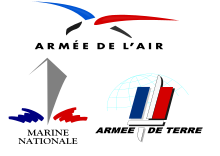Armée française
| French Armed Forces | |
|---|---|
| Forces armées françaises | |

Emblem of the French Republic
|
|

Logo of the French Armed Forces
|
|
| Founded | 1792 |
| Service branches |
French Army French Navy French Air Force National Gendarmerie National Guard |
| Headquarters | Paris |
| Leadership | |
| Commander-in-Chief |
|
| Minister of the Armed Forces |
|
| Chief of the Defence Staff |
|
| Manpower | |
| Military age | 17.5 |
| Conscription | None |
| Active personnel | 365,835 (2014) |
| Reserve personnel | 52,680 reserve (2015)(Gendarmerie inclued) |
| Expenditures | |
| Budget | €40.5 billion (2017) Note: Incl. Gendarmerie budget |
| Percent of GDP | 1.7% (2014) |
| Industry | |
| Foreign suppliers |
|
| Related articles | |
| History | Military history of France |
The French Armed Forces (French: Forces armées françaises) encompass the French Army, the French Navy, the French Air Force, the French National Guard and the National Gendarmerie of the French Republic. The President of France heads the armed forces, with the title "chef des armées" ("chief of the armed forces").
France maintains the sixth largest defence budget in the world and the largest armed forces in size in the European Union (EU). France also maintains the world's third-largest nuclear deterrent (behind Russia and the United States).
The military history of France encompasses an immense panorama of conflicts and struggles extending for more than 2,000 years across areas including modern France, greater Europe, and French territorial possessions overseas. According to the British historian Niall Ferguson, France has participated in 50 of the 125 major European wars fought since 1495, and in 168 battles fought since 387 BC, they have won 109, drawn 10 and lost 49: this makes France the most successful military power in European history—in terms of number of fought and won.
The Gallo-Roman conflict predominated from 60 BC to 50 BC, with the Romans emerging victorious in the conquest of Gaul by Julius Caesar. After the decline of the Roman Empire, a Germanic tribe known as the Franks took control of Gaul by defeating competing tribes. The "land of Francia," from which France gets its name, had high points of expansion under kings Clovis I and Charlemagne. In the Middle Ages, rivalries with England and the Holy Roman Empire prompted major conflicts such as the Norman Conquest and the Hundred Years' War. With an increasingly centralized monarchy, the first standing army since Roman times, and the use of artillery, France expelled the English from its territory and came out of the Middle Ages as the most powerful nation in Europe, only to lose that status to Spain following defeat in the Italian Wars. The Wars of Religion crippled France in the late 16th century, but a major victory over Spain in the Thirty Years' War made France the most powerful nation on the continent once more. In parallel, France developed its first colonial empire in Asia, Africa, and in the Americas. Under Louis XIV, France achieved military supremacy over its rivals, but escalating conflicts against increasingly powerful enemy coalitions checked French ambitions and left the kingdom bankrupt at the opening of the 18th century.
...
Wikipedia
